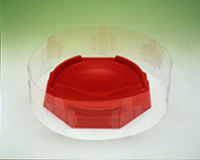|
WHAT'S COOL IN JAPAN April-June 2001
|
|
Beyblades
|
 "Three, two, one, go shoot!" Since the beginning of this year, there has been a sharp increase in the number of elementary school students who can be seen standing in circles in toy stores or on street corners calling out these words as they battle with tops. These kids are called "bladers," and they spin plastic tops in a dish-shaped "stadium" about 40 centimeters (16 inches) in diameter. Two players spin their tops at the same time, and the battle between the tops is so intense that sometimes even sparks can be seen. The match is won when one top pushes the other out of the stadium or spins longer than the other.
"Three, two, one, go shoot!" Since the beginning of this year, there has been a sharp increase in the number of elementary school students who can be seen standing in circles in toy stores or on street corners calling out these words as they battle with tops. These kids are called "bladers," and they spin plastic tops in a dish-shaped "stadium" about 40 centimeters (16 inches) in diameter. Two players spin their tops at the same time, and the battle between the tops is so intense that sometimes even sparks can be seen. The match is won when one top pushes the other out of the stadium or spins longer than the other.
What is it about these toys, called Beyblades, that has captured children's fancy? Ask kids and you're likely to hear, "It's cool because you can modify them the way you want," or, "It's fun to battle with other players because there are so many different tops." There are even some kids who have collected more than 50 Beyblades.  These conical tops are between 2 and 6 centimeters (0.8 and 2.3 inches) high and have diameters of between 5 and 10 centimeters (2 and 4 inches). They come in many different colors and designs. What makes Beyblades so special is that they are made up of five parts--bit chip, attack ring, weight disc, spin gear, and blade base--and can be made to specialize in attack, defense, or balance depending on the combination of parts.
These conical tops are between 2 and 6 centimeters (0.8 and 2.3 inches) high and have diameters of between 5 and 10 centimeters (2 and 4 inches). They come in many different colors and designs. What makes Beyblades so special is that they are made up of five parts--bit chip, attack ring, weight disc, spin gear, and blade base--and can be made to specialize in attack, defense, or balance depending on the combination of parts.
Beyblades first went on sale in July 1999, and a comic about kids who play with them began to appear in a comics magazine at about the same time. A related video game was also released for Nintendo's GameBoy machine. But what really set off the boom was a TV cartoon series that began airing in January 2001. Since then, the manufacturer of Beyblades has had difficulty keeping up with the demand, and toy stores and supermarkets across Japan have been selling out of these hot products. Some people have had to stand in line for three hours to buy them! Beyblades are modeled after a similar type of top, called beigoma, that was popular as a children's toy beginning in the seventeenth century. Beigoma were originally made by filling spiral seashells with sand and melted lead, but at the beginning of the twentieth century they came to be made out of cast iron. They gradually lost their popularity, however, as various new toys and games began to appear after World War II. Today there is only one factory in all of Japan that still makes these tops. Beigoma are usually spun on matting spread across the top of a barrel and indented at the center. Two players spin their tops at the same time and try to knock the opponent's top out of the ring--the same as Beyblades. The way the tops are spun is quite different, however. A beigoma is spun using a 60-centimeter (2-foot) cotton cord. Because a beigoma doesn't have a stem, it takes skill to wrap the cord around the toy. Beyblades, on the other hand, are spun with launching devices called shooters, making it easy for anyone to spin the tops and enjoy playing with Beyblades. Thanks to the popularity of Beyblades, beigoma have been making a comeback from a decades-long slump that almost left them extinct. Japan's only maker of beigoma has seen orders for these tops nearly double since the appearance of Beyblades. Some schools have introduced beigoma as an extracurricular activity, and one school has even held a schoolwide beigoma tournament. Both the new and traditional tops can be expected to continue winning over lots of new fans.
Photos: (Top) These are just a few of the Beyblades and shooters that are available; (above) the stadium can also be chosen from among several types. (©HUDSON SOFT / TAKARA, Beyblade Project, TV Tokyo)
|
 |